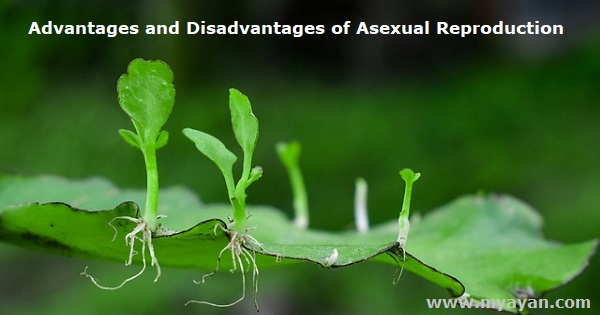Asexual Reproduction is possible in animals but still has a long way to be applied to humans. Some animals can be produced from just one parent; for example, reptiles like as Komodo dragon can have only one parent. Can it ever be possible with humans? Many plants and animal species can reproduce without fertilizing egg cells.
The process that leads to asexual Reproduction is Parthenogenesis that occurs in both animals and plants. The question is, is Asexual Reproduction beneficial always? The Advantages and Disadvantages of Asexual Reproduction list out more pros and cons.
Asexual depends on a single parent and never involves reduction or ploidy. The offspring shares the same traits and characteristics as the parent. Since it can be done on a single-cell organism, there are many advantages of Asexual Reproduction.
With Asexual reproduction, the population of single-cell organisms can grow twice as fast as multi-cellular organisms. Four asexual adults (females) can reproduce eight offspring, but only four offspring can be reproduced with two males and two females. This type of reproduction offers the ability to produce large quantities of offspring.
All the processes of Asexual Reproduction, namely, Binary Fission, Budding, Fragmentation, Vegetative Propagation, and Sporogenesis, take place in the absence of movement. Organisms can reproduce without moving to another place provided they get optimum conditions for survival. It’s to be noted that many plants and animals that tend to move less are mainly able to create offspring independently.
Finding a mating body for and the organism can be complicated, especially for species living in desolate environments, such as deep-ocean ecosystems. Through Asexual reproduction, it is possible to multiply their population without having to find a mate. Plants and animals organisms that exist in the most complicated environment can increase their numbers reproducing through thier single cell.
This type of reproduction doesn’t harm the environment since everything occurs naturally. Unlike mammals, single-cell organisms don’t have weaknesses in harsh survival conditions. The organisms produced through asexual reproduction have low susceptibility to environmental threats, and can grow without parental care.
Vegetative Propagation is the best example of Asexual Reproduction from an Agricultural viewpoint. Certain asexual plants like sugarcane can produce as many clones or offspring as they can without considering any investment to make on your end. Farmers can reap these advantages of Asexual Reproduction as they don’t have to invest much in producing sugarcane crops.
There are several disadvantages of asexual reproduction to consider besides the benefits. Since several animals also reproduce asexually, it’s important to keep their population under control as they share the same genetic structure and characteristics. Also, the same type of organisms pose a threat to other species that co-exist.
Since the offspring inherits only one parent's characteristics and traits, asexual reproduction would hinder genetic diversity, leading to duplicity. The population produced through asexual reproduction will be identical in appearance, features, and behavior. There is no possibility to ensure a diverse ecosystem.
A defected single parent is most likely to produce the same offspring through asexual reproduction. Since it requires a single asexual parent from which chromosomes and genes are copied, the offspring's genetic defects or mutations still exist without any exception. Mutations can lead to unfavorable changes in the next generation of offspring, one of the disadvantages of Asexual Reproduction.
Reproducing the offspring without a mate means all of the same traits and characteristics are inherited from a single parent. This entails that all of the same weaknesses, diseases, will also affect the offspring. It can be assumed that a certain parasite or predator evolved to kill a particular asexual organism will be able to take out its entire population hence, making it set to the verge of extinction.
Since the population can grow rapidly through asexual reproduction, competition in the breeding process does not exist as each organism can reproduce independently, no matter what the environment outside is. A doubled- increment in the population in every reproducing cycle means disturbance in the ecosystem.
Some organisms cannot adapt to certain conditions; establishing reactions to such conditions means the same features would be passed on to the successor generations. Since the same would be transferred to the offspring, they would be less likely to survive the unfavorable conditions due to being reactive.
Conclusion:
Asexual Reproduction is important for organisms in extremely rare conditions or where mating partners have ceased to exist. However, the same can be dangerous for co-existing organisms as one species' overgrown population can overpower or kill them. By knowing the advantages and disadvantages of Asexual Reproduction, it's easier to take care of the organisms and the environment around them.

1. It's a simple application.
2. It allows for quick population.
3. It does not need to be mobile.
4. It does not need mating.
5. The environment is kind to it.
1. Asexual organisms tend to retain harmful changes for a longer period of time.
2. Diversity is restricted.
3. Population amounts might be difficult to manage.
4. There may be a lack of adaptation.
1. Bacteria and Binary Fission.
2. Blackworms and Fragmentation.
3. Budding and Hydras.
4. Copperheads and Parthenogenesis.
5. Strawberries and Vegetative Propagation
Fission, separation, budding, vegetative propagation, spore formation, and Agamogenesis are many methods of asexual reproduction.